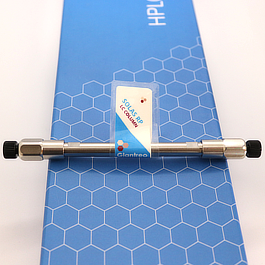PEG-PPG-PEG (Pluronic P123) symmetric triblock copolymer constitutes of poly(ethylene oxide)(PEO) and poly (propylene oxide) (PPO).
The unique characteristic of PPO block exhibiting hydrophobicity at temperatures above 288K and solubility in water at temperatures below 288K lead to formation of micelle consisting of PEO-PPO-PEO triblock copolymers.
Some studies report that the hydrophobic core contains PPO block and a hydrophilic corona is comprised of PEO block. In 30wt% aqueous solution Pluronic P123 forms a cubic gel phase.
Hard and soft surface cleaners, defoamers in coatings and water treatment. Lubricant in metal working, anti-foaming aid and extender for linear and cross-linked polyesters and polyurethanes.
PEG-PPG-PEG is used in the preparation mesoporous silicas including SBA 15
If you have published and cited Glantreo’s materials then click here to let us know.
Clifford A. Barnes, Andreas Elsaesser, Joanna Arkusz, Anna Smok, Jadwiga Palus, Anna Lesniak, Anna Salvati, John P. Hanrahan, Wim H. de Jong, Elzbieta Dziubaltowska, Maciej St?pnik, Konrad Rydzynski, George McKerr, Iseult Lynch, Kenneth A. Dawson and C. Vyvyan Howard, Reproducible Comet Assay of Amorphous Silica Nanoparticles Detects No Genotoxicity. Nano Letters, 2008, 8 (9), pp 3069–3074. doi: 10.1021/nl801661w http://pubs.acs.org/doi/abs/10.1021/nl801661w#citing
Makoto Ema∗, Norihiro Kobayashi, Masato Naya, Sosuke Hanai, Junko Nakanishi, Reproductive and developmental toxicity studies of manufactured nanomaterials, Reproductive Toxicology 30 (2010) 343–352
Iseult Lynch, Sara Linse, C Vyvyan Howard, Maciej Stepnik, Konrad Rydzynski, John Hanrahan, Wim de Jong, Dominique Langevin, Joachim Rädler, Wolfgang Parak, Yuri Volkov, Marek Radomski, Robert Thomas, Jacob Klein, Andrew A Barron, Colin Janssen, Fiona M Lyons, Francis Quinn, Bert Swennen, Peter Cuypers, Angela Duffy and Kenneth A Dawson, NANOINTERACT: A rational approach to the interaction between nanoscale materials and living matter, Journal of Physics: Conference Series Volume 170 Number 1.doi:10.1088/1742-6596/170/1/012040 http://iopscience.iop.org/1742-6596/170/1/012040/cites
Bashir Mustafa Mohamed, Navin Kumar Verma, Adriele Prina-Mello, Yvonne Williams, Anthony M Davies, Gabor Bakos, Laragh Tormey, Connla Edwards, John Hanrahan, Anna Salvati, Iseult Lynch, Kenneth Dawson, Dermot Kelleher,and Yuri Volkov, Activation of stress-related signalling pathway in human cells upon SiO2 nanoparticles exposure as an early indicator of cytotoxicity. Journal of Nanobiotechnology. 2011;9:29. doi:10.1186/1477-3155-9-29.http://www.jnanobiotechnology.com/content/9/1/29
Margriet V.D.Z. Park a,b,⁎, Wijtske Annema a, Anna Salvati c, Anna Lesniak c, Andreas Elsaesser d, Clifford Barnes d, George McKerr d, C. Vyvyan Howard d, Iseult Lynch c, Kenneth A. Dawson c, Aldert H. Piersma a,e, Wim H. de Jong a, In vitro developmental toxicity test detects inhibition of stem cell differentiation by silica nanoparticles, Toxicology and Applied Pharmacology 240 (2009) 108–116
Markus Roller, In vitro genotoxicity data of nanomaterials compared to carcinogenic potency of inorganic substances after inhalational exposure, Mutation Research 727 (2011) 72–85
Mostafa Yazdimamaghani, PhDa,b, Philip J. Moos, PhDb,c, Marina A. Dobrovolskaia, PhDd, Hamidreza Ghandehari, PhD, Genotoxicity of amorphous silica nanoparticles: Status and prospects, Nanomedicine: Nanotechnology, Biology, and Medicine 16 (2019) 106–125


